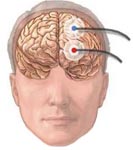Fiction Close To Becoming Reality: Brain Sensors To Create bionic Movement
 In what is being seen as a revolutionary innovation that will allow patients, paralyzed in accidents which damage the spine, to relearn how to move. A group of engineers in the UK have contributed to the development of a micro technology that could well enable amputees to move artificial limbs through the power of their brains.
In what is being seen as a revolutionary innovation that will allow patients, paralyzed in accidents which damage the spine, to relearn how to move. A group of engineers in the UK have contributed to the development of a micro technology that could well enable amputees to move artificial limbs through the power of their brains.
The micro-needle sensor array has been manufactured by Cardiff University's MicroBridge Services and is around the size of a matchstick head. Each of the sensor array's 100 needles, which have been crafted from conduction-friendly tungsten carbide and are as thick as a human hair, penetrate the brain's surface, picking up electrical activity and nerve impulses and then amplifying and delivering that vital information to the waiting prosthetic attachments.
Dr. Robert Hoyle of MicroBridge Services said "The more needles you can get on a sensor in the smallest possible area, the better control a patient will get over his or her prosthetic limb. The challenge for us now is to make the needles smaller so that we can pack more onto a sensor."
An American team had already been successful, developing implants capable of manipulating computers and prosthetic appendages. But the implants had been made of silicon which proved to be brittle and had a useful life of less than a year. Researchers at Utah University, in the USA, asked the Cardiff University to develop micro-needle array sensors, which are durable. As a pioneer in its field, its ability to manufacture the tiny micro-needle array, precisely using an extremely strong material, proved vital.
A patient fitted with an implant, literally has to learn to think the correct mental activity to get the required response from the system. Weeks of training is necessary but tests on volunteers have already shown promising results.